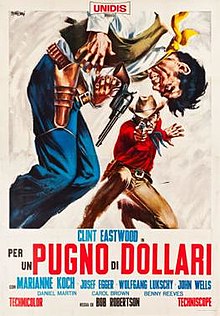Title: A Fistful Of Dollars
Rating: 3 Stars
I get why A Fistful of Dollars is considered to be a classic film. It certainly blows up the conventional Western genre. There is no one wearing white hats in this film. The characters are dirty, thieving, and at best, amoral. Even the character played by Clint Eastwood, The Man With No Name (although interestingly enough he is called Joe, so he’s actually The Man With No Name That People Call Joe) isn’t exactly a great guy. Yes, he cleans up the town, but in so doing pretty much aids and abets in destroying it. I’m not even sure what his motivation is. Yes, he helps the young family escape from the clutches of the town gangs, but he seems to be doing it primarily for his own amusement.
Especially compared to the sanitary Westerns, the violence is both more explicit as well as over the top. Hollywood had a standard of never having the gunman shooting the victim in the same shot (the gun shot victim was always a reaction shot). Here, the camera is behind the gunman so you see him raise his gun, shoot the victim, and see the victim die.
In one scene, one gang sets fire to the house of the other gang. As the members stagger out, they are immediately killed as the gunmen laugh. Some try to beg for mercy to no avail. The last one to emerge is the matriarch. As she’s mourning over her dead husband and son, she is shot dead. In another scene, Mexican soldiers meet to trade gold for guns with American soldiers. The American soldiers are actually one of the gangs in disguise. They whip out a Gatling gun and shoot down all of the soldiers. This must be the highest body count in a Western until The Wild Bunch comes along a couple of years later.
The so-called Dollars trilogy, although initially panned as being graphic, gruesome, vulgar, and cheap, proved to be an inspiration to others. You can draw a pretty straight line from this film to The Wild Bunch, the much more graphic anti-Western film directed by Sam Peckinpah. Even later, Clint Eastwood takes what he’s learned and moves the revisionist Western even further with Unforgiven.
Why the three stars? Well, first of all, although Sergio Leone makes due with what he can, it was a low budget film and it shows. The dialog was added later. The dubbing is pretty amateurish. The acting is, to put it charitably, primitive. Leone joked that Eastwood had two faces: hat and no hat.
And then there’s the plot. A nameless gunslinger heads into town. He becomes friends with a saloon keeper and his neighbor the coffin maker. He sees two gangs that are fighting in the town for dominance while the town residents cower in fear. One gang is led by a man, his wife, and their somewhat useless son. The other is led by a ruthless man. He is holding a woman as his hostage captor over her husband’s bogus gambling debt. The gunslinger alternately pretends to side with one gang or the other. He secretly does things that sets the gang members against each other. He finds where the woman is being held, kills all of her guards, reunites the woman, husband, and child and sends them off to safety. One of the gangs get the upper hands and essentially destroys the other gang. The gunslinger’s treachery is discovered by the victorious gang. He is captured, beaten, and tortured. He escapes and leaves town in a coffin to avoid capture. Once he gets his strength back, he comes back and takes down the victorious gang. The town, now free of strife, can live peacefully. His work done, the gunslinger leaves town permanently.
This sounds like a fairly complicated, original plot, right? Well, except for the fact that it also happens to be the exact same plot as Akira Kurosawa’s Yojimbo, made three years earlier in 1961. In the above paragraph, substitute the word gunslinger with ronin and it is exactly the plot of Yojimbo. There are stories that, during fight scenes, Leone watched Yojimbo as he was filming them.
Unfortunately, Leone somehow neglected to credit Yojimbo. This led the Japanese production company to sue Leone.
It’s interesting that one of the defenses of this film was that Yojimbo itself was based upon the Hammett classic Red Harvest. To the extent that you have a nameless man (in this case a Continental operative) coming into a town with two rival gangs and then he cleans up the town by sicking the two gangs onto each other, that’s true. However, there are many plot details in Yojimbo that makes it distinct from Red Harvest.
Ultimately, it all kinda worked out. Kurosawa got something like 10 to 15 percent of the profits from the film when it was screened in Japan and Korea. He ended up making more money than he did originally with Yojimbo.
Still, it was kind of a scummy thing to do and it tarnishes the film a bit.

One thought on “A Fistful Of Unauthorized Remake”